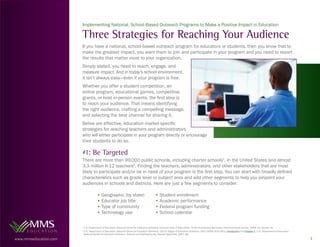Promoting School-Based Programs
- 1. Implementing National, School-Based Outreach Programs to Make a Positive Impact in Education Three Strategies for Reaching Your Audience If you have a national, school-based outreach program for educators or students, then you know that to make the greatest impact, you want them to join and participate in your program and you need to report the results that matter most to your organization. Simply stated, you need to reach, engage, and measure impact. And in today¡¯s school environment, it isn¡¯t always easy¡ªeven if your program is free. Whether you offer a student competition, an online program, educational games, competitive grants, or host in-person events, the first step is to reach your audience. That means identifying the right audience, crafting a compelling message, and selecting the best channel for sharing it. Below are effective, education market-specific strategies for reaching teachers and administrators who will either participate in your program directly or encourage their students to do so. #1: Be Targeted There are more than 99,000 public schools, including charter schools1 , in the United States and almost 3.3 million K-12 teachers2 . Finding the teachers, administrators, and other stakeholders that are most likely to participate and/or be in need of your program is the first step. You can start with broadly defined characteristics such as grade level or subject area and add other segments to help you pinpoint your audiences in schools and districts. Here are just a few segments to consider: ? Geographic (by state) ? Student enrollment ? Educator job title ? Academic performance ? Type of community ? Federal program funding ? Technology use ? School calendar 1 U.S. Department of Education, National Center for Education Statistics, Common Core of Data (CCD), ¡°Public Elementary/Secondary School Universe Survey,¡± 2009¨C10, Version 1a. 2 U.S. Department of Education, National Center for Education Statistics. (2012). Digest of Education Statistics, 2011 (NCES 2012-001), Introduction and Chapter 2 ; U.S. Department of Education, National Center for Education Statistics, Schools and Staffing Survey, Teacher Data Files, 2007¨C08. www.mmseducation.com 1
- 2. #2: Be Relevant Educators have to make choices about what programs they can implement in their schools and classrooms and how to best invest one of their most valuable resources?¡ªtheir time. Your messages to educators should call out what benefits they, or their students, will derive from participating, how your program relates to their curriculum goals, and how they will interact with you and your program. Remember to: ? Share the critical issue your program addresses and leverage any national attention it has received ¡ªwhether it¡¯s enhancing STEM education or preparing students for 21st century careers. ? Highlight any educational trends your program relates to such as project-based learning, Common Core State Standards, educational games, mobile learning, open educational resources, or others. ? Let potential participants know how they can interact with your program?¡ªonline, during the day, after school, or with other educators. They will want to know how much time they need to implement the program effectively and if there are different implementation models they can follow. #3: Be Direct When you market your program, even when it is free to schools, you can borrow from the education marketer¡¯s toolbox! Direct marketing channels descibed below can be used independently, and there¡¯s a tremendous benefit to building an integrated campaign. Selectively utilize the best channels to support your campaign goals, whether that¡¯s building awareness, recruiting participants, announcing grants, soliciting feedback, or sharing ongoing announcements. Whichever channels you select, you¡¯ll want to track and measure results. Understanding how individuals respond to your campaigns will help you refine future campaigns. Email: More teachers are accessing their email outside of school than ever before¡ªeven throughout holidays and during summer break. Direct Mail: Today¡¯s sophisticated print options let you boost personalization to create custom-tailored messages for people you want to reach. And with uniquely shaped postcards or ¡°lumpy¡± mail, there¡¯s room to stand out in the mailbox. www.mmseducation.com 2
- 3. Telephone: Direct, person-to-person contact is a valuable way of providing the personalized support educators appreciate. Whether it¡¯s confirming a registration or handling incoming calls to help participants log in to a website, a meaningful telephone support strategy can help build and nurture relationships with your participants. Advertising: Educational associations offer many advertising choices for their websites, e-newsletters, and print publications. You can use print and online advertising to promote your program, drive visits to your website or online enrollment forms, and more. Social Media: Social media can reveal actionable program and market insights. And there are social media sites geared specifically to educators; some are promotional, some offer online communities, and others help to deliver professional development and training. Be selective and relevant with your audience, and be direct when promoting your outreach program. Our upcoming article ¡°Supporting Your Program¡± shares specific field wisdom that you can use to define how you will provide technical assistance and program support to build and nurture relationships with your stakeholders. About MMS Education¡ªMMS Education helps organizations make a difference in schools. For more than 35 years, we¡¯ve helped corporate foundations, grant makers, associations, and for-profit companies achieve their goals in education. Current and recent nonprofit clients and their projects include: ¡ö National Dairy Council (Fuel Up to Play 60) ¡ö Verizon Foundation (Thinkfinity) ¡ö The American Heart Association (Be the Beat) ¡ö Christopher Columbus Fellowship Foundation (Christopher Columbus Awards) We know how to help you reach and attract your audience, help them understand and use your program or service, and help you track and measure your outreach efforts. If you have a challenge to meet or an opportunity to address, learn how we can help at www.mmseducation.com, or contact Kelly Stewart at 800-523-5948, extension 3122, or kstewart@mmseducation.com. ? 2012 MMS Education. If you wish to expand distribution, reprint, or otherwise use this information, please request permission from MMS Education. Thank you. 3www.mmseducation.com



